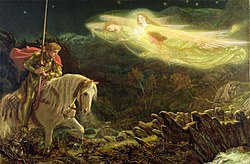Holy Grail

The Holy Grail is an artifact from Christians beliefs. According to a story, it is the cup or plate used by Jesus at the Last Supper. It was later used to catch his blood when he had to die on the cross.
According to the story, it has special powers. Many stories of the Arthurian Legend are about the Holy Grail. The first to write about it was Chrétien de Troyes.[1] The legend may combine Christian lore with a Celtic myth of a cauldron which has special powers.
The connection of Joseph of Arimathea with the Grail legend dates from Robert de Boron's Joseph d'Arimathie. In the story, Joseph receives the Grail from an apparition of Jesus Christ, and sends it with his followers to Great Britain; building upon this theme, later writers told how Joseph used the Grail to catch Christ's blood while burying him and that in Britain he founded a line of guardians to keep it safe.
A cup that could have been the Holy Grail can be seen in Valencia Cathedral.
The term "Holy Grail" is often used as a metaphor for something very important or special.
Holy Grail Media
Galahad, Bors and Percival achieve the Grail. Tapestry woven by Morris & Co. (19th century)
Sir Galahad, the Quest for the Holy Grail by Arthur Hughes (1870)
The Holy Grail depicted on a stained glass window at Quimper Cathedral
Die Gralsburg (The Grail Castle) by Hans Thoma (1899)
King Pelles' Daughter Bearing the Sancgraal by Frederick Sandys (1861)
Grail diary of Henry Jones, Sr. from the 1989 film Indiana Jones and the Last Crusade at the Hollywood Museum
References
- ↑ Loomis, Roger Sherman (1991). The Grail: From Celtic Myth to Christian Symbol. Princeton. ISBN 0-691-02075-2 [1] Archived 2020-04-07 at the Wayback Machine







